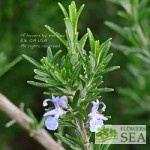 | Flowers by the Sea cultivates many fragrant, flavorful culinary sages -- also referred to as "kitchen sages" -- that are easy to grow and tolerate drought. These attractive sages are found in many parts of the world, including Africa, Central and South America, the Middle East, the Mediterranean and South Africa. For robust flavor and fragrance, there's nothing quite like culinary sage fresh you're your own garden. The two species most familiar to Western cooks are the Mediterranean herbs Common or Culinary Sage (Salvia officinalis) and Greek Sage (S. fruticosa). Although most often used as a rub on poultry, meats and fish, culinary sages are also tasty in breads, omelettes, sauces such as pesto, soups, stews and vegetarian main dishes. Some taste and smell fruity. In these days of fashionable fusion cuisine, you can even find these herbs in ice cream. Edible Salvias have a long history of medicinal use, such as in teas. The genus name Salvia comes from the Latin verb salvare, which means to save. It is related to Salus, the Roman goddess of well-being who was an adaptation of the Greek goddess of health, Hygeia. Ancient healers in both Greece and Rome used edible Mediterranean Salvias as folk remedies. Over time, these sages also became favorite seasonings. It isn't necessary to limit culinary sages to kitchen gardens. They perfume the landscape, add interest to sunny borders and offer many kinds of handsome foliage, including ones with pebbly textures. Due to this appeal to the eye and the senses of smell and touch, culinary sages are ideal additions to therapy gardens. |
(Pineapple Sage) An indispensable fall-blooming addition to the garden, this tender perennial is, perhaps, the best of all hummingbird plants. When in bloom, it is covered in 3-inch-long red flowers.
(Elk Sonoran Red Pineapple Sage) A new Pineapple Sage variety that has the traditional fruity fragrance but blooms much earlier in the season than the traditionally grown clone. Short and compact, it resembles the varieties 'Honey Melon' and 'Tangerine' size wise, but has the unmistakable aroma of ripe pineapples.
(Frieda Dixon Pineapple Sage) Most varieties of Salvia elegans have bright red flowers. But Frieda Dixon Pineapple Sage, which blooms abundantly beginning in late fall, has softer salmon-pink blossoms set against mid-green, lance-shaped leaves.
(Honey Melon Pineapple Sage) This is a short Pineapple Sage that is long blooming. It is the earliest and longest flowering of all the many varieties of Salvia elegans. We recommend it for indoor herb gardening as well as for outdoor borders and groundcovers.
(Tangerine Pineapple Sage) This citrus-scented cultivar is our smallest variety of Pineapple Sage. Worth growing just for the exotic scent of its leaves, this culinary sage is also one of the longest blooming plants in its species.
(Greek Sage) Most of the dried culinary sage sold in the United States is Greek Sage. Frescoes on the island of Crete dated to 1400 BC depict this plant, which was used by the Phoenicians and Greeks for cooking and medicine. It is an ancient and beloved friend of mankind.
(Jerusalem Sage) This lovely herbaceous perennial is native to Cyprus, Israel, Jordan, Lebanon, Syria, and the West Bank. Its clear pink flowers change at times to a pink highlighted with violet lines and dots. Prominent glandular hairs on the buds, bracts and floral stems exude a fragrance that is delightful on a warm day.
(Clary or Clear Eye Sage or Eyebright) Pink-purple bracts and violet-purple flowers form a pastel cloud over the large, rumpled leaves of Clary Sage in summer. It is a towering beauty growing up to 5 feet tall. Sacred to some due to age-old use in herbal remedies, it is heavenly to look at.
(Italian Clary Sage) Clary Sages are well known for their use in folk remedies, aromatherapy and cosmetics. Glowing purple bracts frame the spectacular white blooms of this cultivar on 5-foot-tall spikes. It is a delight for honeybees, hummingbirds and butterflies.
(Vatican White Clary Sage) Clary Sages are well known for their use in folk remedies, aromatherapy and cosmetics. Large white bracts frame the spectacular white blooms of this cultivar on 5-foot-tall spikes. It is a delight for honeybees and butterflies.


















